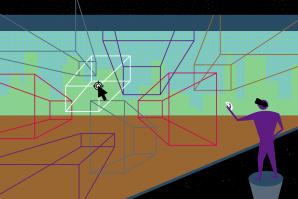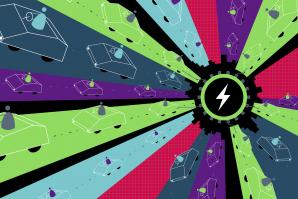In the early 1970s, a team of scientists rounded up 117 pairs of twins and gave them a suite of tests designed to assess aptitude for creativity with directives like, “Brainstorm all the different things you can do with a brick.”
The results were stunning. Twins that shared identical DNA had massive differences in their creative abilities — specifically, genetics explained only 30 percent of creativity. Compare that to a trait like intelligence (at least in the traditional, narrow sense of testable IQ), where up to 85 percent can be explained by our genes.
“Some of us are born with it, and those who are born with it have a responsibility to foster innovation in others.”Alona Jennings, co-founder, Operation Innovate
So, is the ability to innovate something that we’re born with, like height, or is it something that we can cultivate with practice, education and tweaks to our behavior? “I honestly think that it’s around 50/50,” says Alona Jennings, co-founder of Sacramento´s Operation Innovate, a nonprofit organization that mentors low-income youth. “Some of us are born with it, and those who are born with it have a responsibility to help foster innovation in others.”
Related: Alona Jennings on Leveraging Regional Diversity
That was also the conclusion reached by Jeff Dyer, Hal Gregersen and Clayton M. Christensen — researchers who collected data from 5,000 executives in 75 countries, hoping to find the common characteristics of innovators. “A critical insight from our research is that one’s ability to generate innovative ideas is not merely a function of the mind, but also a function of behaviors,” explain the authors. “If we change our behaviors, we can improve our creative impact.”
After poring through the data, they found that innovators tend to do five things better than the rest of us: question, observe, network, experiment and associate.
Essentially, instead of passively hoping that an idea will strike us or assuming that we’re just not the “creative type,” we can actively focus on these five habits, and help grow them in others:
Question (Everything)
Innovators challenge the status quo — that’s the origin of new solutions. Jennings encourages a questioning mindset in the kids she mentors through Code For Hood, a program of Operation Innovate that runs workshops and hackathons to develop skills like coding, software development and video game design.
“I tell kids, don’t think about ‘what could I invent?’” she says, instead directing them to ask questions and seek problems. One of her mentees recently whipped up an idea for an app that lets people at different locations watch Netflix together at the same time. “This app helped solve a problem: When families have someone overseas in the military, how do they stay in touch? Or how do you stay close to someone in a long distance relationship? Always look for problems in the world,” she says.
This works in larger corporations, too. Kim Box is the president and CEO of Gatekeeper Innovation, which is a start-up that produces devices to lock prescription pill bottles, but she formerly led a division of Hewlett-Packard that had 15,000 employees and a $1 billion budget. Even working for the corporate behemoth, she asked tough questions. When tasked with slashing the costs and boosting the efficiency of HP’s call center, which serviced 120 countries and was the largest of its kind on the planet, “I asked my team, if you were to design this call center from scratch, what would it look like?” she says. “We called it the Zero Base Building.” That led her team to surprising new places, such as “load balancing,” where a customer service team in Europe, for example, would pick up the slack from calls in the U.S., leveraging the changes in time zones. “This sounds obvious now, but it required a ton of training and re-thinking,” Box says.
Observe (Constantly)
Observations fuel ideas. “Good innovators spend a lifetime listening and learning, so that when the right puzzle piece presents itself, they can snap it into place,” says Louis Stewart, Sacramento’s Chief Innovation Officer (and member of Comstock’s editorial board). “Listening is key. It speeds up your connectivity if you can soak up those little morsels.”
And what we observe also matters. That’s why Stewart exposes himself to a wide range of media. “I consume everything, from podcasts to the news to watching shows on Netflix, as you never know where the spark will come from.” (Before you binge “Stranger Things” and call it work, Stewart quickly clarifies that he means Netflix documentaries.)
Stewart is no outlier. All innovators devour content. “I read excessively, all the time,” says Pam Marrone, CEO of Marrone Bio Innovations, a biotech company focused on pest management and plant health. She drinks from the fire-hydrant of Twitter, LinkedIn, industry newsletters, Fast Company and Wired. “I do feel like only the paranoid survive,” she says, “and that I have to be on top of the latest trends.” Books play a role. While traveling on planes, Marrone says she speed-reads one book per flight on her iBooks app (she likes Annie Proulx novels, The Moth Snowstorm and The Innovator´s Dilemma, to name a few).
Network (Wisely)
At The Urban Hive, a coworking space in Midtown Sacramento, you’ll find a large open kitchen that they call, well, The Kitchen. Founder Brandon Weber, who is also the founder of I/O Labs (a coworking space much larger than the Hive geared toward innovators, entrepreneurs and investors), describes The Kitchen as “this little insidious room that hasn’t been updated since 1984.” Members will bump into each other, make small talk, grab coffee. “This is where the magic happens,” says Weber, who has seen these coffee sessions morph into meetings with $150-million venture capitalists.
Creative-types flock to The Kitchen because oftentimes great ideas die in solitude. “Good innovators will bounce ideas off each other,” says Marrone. “A lot of non-innovators will suffer in silence and try and work things out alone. Good innovators will use every resource at their disposal.”
On a grander scale, Stewart sees this jostling of ideas as crucial to Sacramento’s innovation. “One of the things that creates successful innovation ecosystems is providing the space for people to meet and talk,” Stewart says. “This helps spark new ideas.”
Beyond coworking spaces and the private sector, the City of Sacramento created the Demonstration Partnership Policy to link the government with private companies, with an eye towards spurring creative solutions. This ecosystem creates surprising partnerships that unlock new ideas, like how a ride-sharing program (Lyft) is working with a health care system (Sutter) to bring moms in lower-income communities to their prenatal care appointments.
Ideally, these types of networks are available for innovators at a young age. To help teenagers tap into their innovative potential, Jennings emphasizes connecting youth to teachers, mentors and programs. “Show them people who are doing it,” she says. “Then give them an opportunity to tinker so they can do it themselves.”
Experiment (Repeatedly)
Rob White, chief strategist for waste gasification company Sierra Energy, spends a lot of time tinkering with trash — his team has taken up the challenge of revolutionizing the way we dispose of it.
With the help of investments from both the Department of Defense and the California Energy Commission, since 2009, Sierra has been developing a new technology called FastOx, which injects oxygen into the burning process and converts trash into clean, renewable energy — including electricity, diesel and hydrogen fuel.
Revolutionizing our waste management will require experimentation, and rigorous trial and error, says White. Sierra’s first gasifier prototype was just a small cylinder about the size of a can of coffee beans. Researchers stuffed the can full of garbage. Then they lit the can with a blowtorch that was enriched with oxygen (this is what separates the process from normal burning), but as White put it, “the torch burned all the way through to the other side of the can.” The scientists redesigned the prototype to squish it down so that it’s fatter in the middle, giving more room for the burn. This worked. The prototype is now a reality, and Sierra is actively selling units which convert trash to energy.
“When we talk about innovators at Sierra, we’re looking for people who can not only see down the road, but also see seven or eight ways to get there,” White says. “They might pick one path and execute, but then they’re flexible enough to try something else.”
The best innovators, according to Marrone, are the ones who can quickly spot a dead-end, recover and adapt. “Innovation is not about aha,” she says. “A lot of it has to do with persistence, determination and adaptability. When something doesn’t work, you quickly pivot.”
Associate (Like a Weirdo)
Einstein once described the creative process as “combinatorial play,” meaning the art of joining things together. This is where all that observing, consuming and questioning pays off. “When the brain is actively absorbing new knowledge, it is more likely to trigger connections between ideas, thus creating a wider web of neural connections,” explain Christensen, Dryer and Gregersen. “In our research, every high-profile innovator excelled at associating.”
Weber agrees. “Sometimes innovation is just about saying, ‘Hey, this already exists, and that already exists, so why isn’t someone connecting these two things?’” Airbnb, for example, connected pockets of unused or underutilized housing with people who needed a bed. Uber did the same for cars.
If you ask Jennings, this knack for associational thinking might go hand in hand with, well, just being a touch different. “Innovators are a little more,” she pauses, searching for the right word, “quirky than the rest of us. Many of them don’t really fit in. They speak a bit differently, they interpret the world differently — and that allows them to be a little more creative, and think outside the box.”
And while it’s tough to tell someone to just “be weird” in the hopes of flexing their creativity, it’s also true that an accepting — and encouraging — environment can make all the difference. “The reality is that the environment impacts the people as much as the people impact the environment,” says White, who dreams of seeing Sacramento as a “living laboratory,” a test-bed for new ideas. “How do we make sure that anyone who wants to do something new, they try it in Sacramento?”
Box, formerly of HP, is already seeing the early signs of this laboratory. “I don’t think we thought of ourselves as a very innovative environment 10 or 20 years ago,” she says. “But in the last five years? It’s changing. We’re focusing attention on innovation, and it’s working. I love it.”
Recommended For You

Dawn of the Developers
Despite a tough climb, indie developers are pushing the Capital Region’s gaming industry to the next level
The Capital Region has a couple of homegrown video game success stories, but most growth is taking place in its community of indie developers. As the region seeks to brand itself more as a tech hub, these gamers want to ensure their industry is part of the push.

Built in 3D
Virtual technology finds real-world applicability in the construction and architecture fields
Virtual reality used to be financially out-of-reach for many firms. Now, builders and architects alike are finding that implementing technology upfront prevents mistakes, and saves money, down the road.

Electric Avenue
How will Sacramento’s designation as a ‘Green City’ shift the transportation landscape?
Last summer, Sacramento learned it would become Volkswagen’s first “Green City,” earning millions in investment from the tarnished brand’s subsidiary, Electrify America. Where will this money go, and what does it mean for the local auto technology industry?

Limits to Launch
Is the UC’s two-tiered tech-transfer system restraining innovation and economic growth?
Tech transfer at publically-funded universities isn’t just about generating revenue from IP — it’s about the public good. But is the UC’s strategy for negotiating licenses making this double-barrelled mission even more complex?



